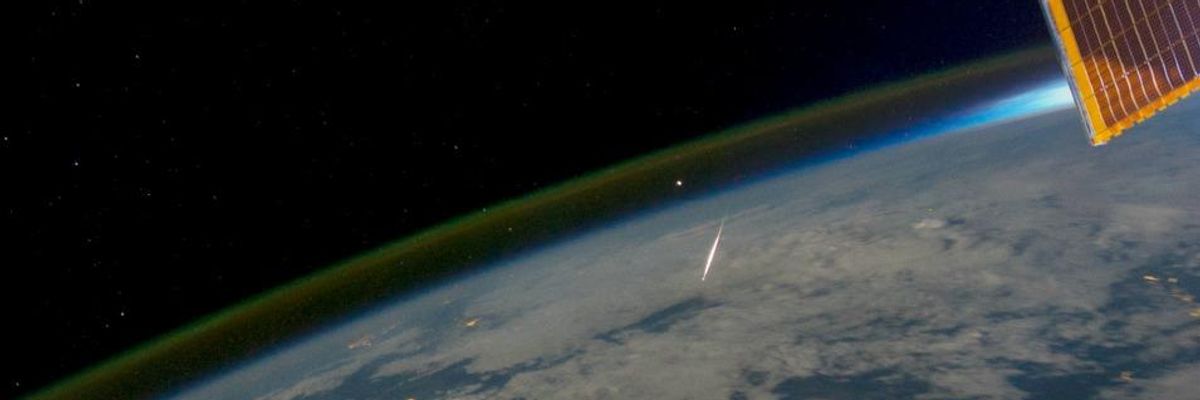

SUBSCRIBE TO OUR FREE NEWSLETTER
Daily news & progressive opinion—funded by the people, not the corporations—delivered straight to your inbox.
5
#000000
#FFFFFF
To donate by check, phone, or other method, see our More Ways to Give page.


Daily news & progressive opinion—funded by the people, not the corporations—delivered straight to your inbox.

Meteor seen from the International Space Station. (Photo: Astronaut photograph from NASA/JSC)
One of the factors stopping the U.S. from eliminating its nuclear weapons stockpile is the potential of an asteroid hurtling towards the planet.
The finding comes from a Government Accountability Office report (pdf) on the National Nuclear Security Administration (NNSA), which oversees the dismantling of the nation's nuclear weapons.
The unusual tidbit from the April 2014 report was noted by Nuclear Watch New Mexico in June, but gathered more media attention this week following reporting by the Wall Street Journal.
In a section listing reasons why the NNSA is not disassembling some "canned subassemblies (CSA)--a major nuclear component that can contain highly enriched uranium (HEU)," it states:
For potential use in planetary defense against earthbound asteroids. NNSA officials told us that CSAs associated with a certain warhead indicated as excess in the 2012 Production and Planning Directive are being retained in an indeterminate state pending a senior-level government evaluation of their use in planetary defense against earthbound asteroids. While NNSA has declared these CSAs to be excess and, until March 2013, had scheduled them for disassembly beginning in fiscal year 2015, the national labs' retention letter has also characterized the CSA associated with this warhead as an "irreplaceable national asset. " The WDD program is coordinating NNSA' s evaluation of their use in planetary defense with the support of LLNL, LANL, and Y-12.
As theoretical physicist and author Michio Kaku explained in a 2013 cover story for Newsweek, a large asteroid hitting the Earth is an unusual but potentially serious threat.
You can hear Kaku discuss the issue--including how a hydrogen bomb could be used--in this light-hearted interview on the Colbert Report:
The Colbert Report
Get More: Daily Show Full Episodes,Indecision Political Humor,The Colbert Report on Facebook
Dear Common Dreams reader, The U.S. is on a fast track to authoritarianism like nothing I've ever seen. Meanwhile, corporate news outlets are utterly capitulating to Trump, twisting their coverage to avoid drawing his ire while lining up to stuff cash in his pockets. That's why I believe that Common Dreams is doing the best and most consequential reporting that we've ever done. Our small but mighty team is a progressive reporting powerhouse, covering the news every day that the corporate media never will. Our mission has always been simple: To inform. To inspire. And to ignite change for the common good. Now here's the key piece that I want all our readers to understand: None of this would be possible without your financial support. That's not just some fundraising cliche. It's the absolute and literal truth. We don't accept corporate advertising and never will. We don't have a paywall because we don't think people should be blocked from critical news based on their ability to pay. Everything we do is funded by the donations of readers like you. Will you donate now to help power the nonprofit, independent reporting of Common Dreams? Thank you for being a vital member of our community. Together, we can keep independent journalism alive when it’s needed most. - Craig Brown, Co-founder |
One of the factors stopping the U.S. from eliminating its nuclear weapons stockpile is the potential of an asteroid hurtling towards the planet.
The finding comes from a Government Accountability Office report (pdf) on the National Nuclear Security Administration (NNSA), which oversees the dismantling of the nation's nuclear weapons.
The unusual tidbit from the April 2014 report was noted by Nuclear Watch New Mexico in June, but gathered more media attention this week following reporting by the Wall Street Journal.
In a section listing reasons why the NNSA is not disassembling some "canned subassemblies (CSA)--a major nuclear component that can contain highly enriched uranium (HEU)," it states:
For potential use in planetary defense against earthbound asteroids. NNSA officials told us that CSAs associated with a certain warhead indicated as excess in the 2012 Production and Planning Directive are being retained in an indeterminate state pending a senior-level government evaluation of their use in planetary defense against earthbound asteroids. While NNSA has declared these CSAs to be excess and, until March 2013, had scheduled them for disassembly beginning in fiscal year 2015, the national labs' retention letter has also characterized the CSA associated with this warhead as an "irreplaceable national asset. " The WDD program is coordinating NNSA' s evaluation of their use in planetary defense with the support of LLNL, LANL, and Y-12.
As theoretical physicist and author Michio Kaku explained in a 2013 cover story for Newsweek, a large asteroid hitting the Earth is an unusual but potentially serious threat.
You can hear Kaku discuss the issue--including how a hydrogen bomb could be used--in this light-hearted interview on the Colbert Report:
The Colbert Report
Get More: Daily Show Full Episodes,Indecision Political Humor,The Colbert Report on Facebook
One of the factors stopping the U.S. from eliminating its nuclear weapons stockpile is the potential of an asteroid hurtling towards the planet.
The finding comes from a Government Accountability Office report (pdf) on the National Nuclear Security Administration (NNSA), which oversees the dismantling of the nation's nuclear weapons.
The unusual tidbit from the April 2014 report was noted by Nuclear Watch New Mexico in June, but gathered more media attention this week following reporting by the Wall Street Journal.
In a section listing reasons why the NNSA is not disassembling some "canned subassemblies (CSA)--a major nuclear component that can contain highly enriched uranium (HEU)," it states:
For potential use in planetary defense against earthbound asteroids. NNSA officials told us that CSAs associated with a certain warhead indicated as excess in the 2012 Production and Planning Directive are being retained in an indeterminate state pending a senior-level government evaluation of their use in planetary defense against earthbound asteroids. While NNSA has declared these CSAs to be excess and, until March 2013, had scheduled them for disassembly beginning in fiscal year 2015, the national labs' retention letter has also characterized the CSA associated with this warhead as an "irreplaceable national asset. " The WDD program is coordinating NNSA' s evaluation of their use in planetary defense with the support of LLNL, LANL, and Y-12.
As theoretical physicist and author Michio Kaku explained in a 2013 cover story for Newsweek, a large asteroid hitting the Earth is an unusual but potentially serious threat.
You can hear Kaku discuss the issue--including how a hydrogen bomb could be used--in this light-hearted interview on the Colbert Report:
The Colbert Report
Get More: Daily Show Full Episodes,Indecision Political Humor,The Colbert Report on Facebook